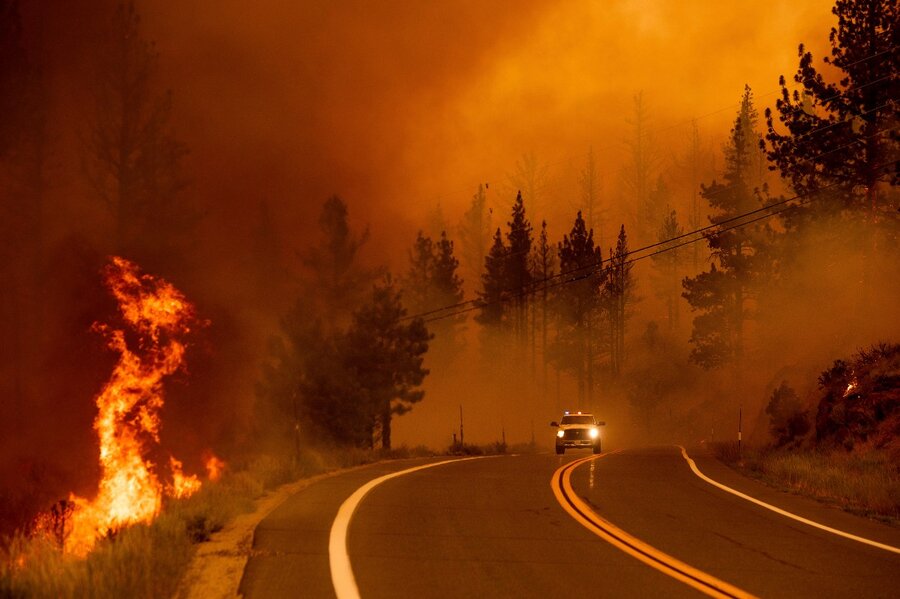A summer like fall: Major US wildfires torch Western forests
Loading...
| Bly, Oregon
The largest wildfire in the U.S. torched more dry forest landscape in Oregon on Sunday, one of dozens of major blazes burning across the West as critically dangerous fire weather loomed in the coming days.
The destructive Bootleg Fire just north of the California border grew to more than 476 square miles (1,210 square kilometers), an area about the size of Los Angeles.
Erratic winds fed the blaze, creating dangerous conditions for firefighters, said John Flannigan, an operations section chief on the 2,000-person force battling the flames.
“Weather is really against us," he said. "It’s going to be dry and air is going to be unstable.”
Authorities expanded evacuations that now affect some 2,000 residents of a largely rural area of lakes and wildlife refuges. The blaze, which was 22% contained, has burned at least 67 homes and 100 outbuildings while threatening thousands more.
At the other end of the state, a fire in the mountains of northeast Oregon grew to more than 17 square miles (44 square kilometers) by Sunday.
The Elbow Creek Fire that started Thursday has prompted evacuations in several small, remote communities around the Grande Ronde River about 30 miles (50 kilometers) southeast of Walla Walla, Washington. It was 10% contained.
Natural features of the area act like a funnel for wind, feeding the flames and making them unpredictable, officials said.
In California, a growing wildfire south of Lake Tahoe jumped a highway, prompting more evacuation orders, the closure of the Pacific Crest Trail and the cancellation of an extreme bike ride through the Sierra Nevada.
The Tamarack Fire, which was sparked by lightning on July 4, had charred nearly 29 square miles (74 square kilometers) of dry brush and timber as of Sunday morning. The blaze was threatening Markleeville, a small town close to the California-Nevada state line. It has destroyed at least two structures, authorities said.
A notice posted Saturday on the 103-mile (165-kilometer) Death Ride's website said several communities in the area had been evacuated and ordered all bike riders to clear the area. The fire left thousands of bikers and spectators stranded in the small town and racing to get out.
Kelli Pennington and her family were camping near the town Friday so her husband could participate in his ninth ride when they were told to leave. They had been watching smoke develop over the course of the day, but were caught off guard by the fire's quick spread.
“It happened so fast,” Pennington said. “We left our tents, hammock and some foods, but we got most of our things, shoved our two kids in the car and left."
About 500 fire personnel were battling the flames Sunday, "focusing on preserving life and property with point protection of structures and putting in containment lines where possible,” the U.S. Forest Service said.
Meteorologists predicted critically dangerous fire weather with lightning possible through at least Monday in both California and southern Oregon.
“With the very dry fuels, any thunderstorm has the potential to ignite new fire starts,” the National Weather Service in Sacramento, California, said on Twitter.
Extremely dry conditions and heat waves tied to climate change have swept the region, making wildfires harder to fight. Climate change has made the West much warmer and drier in the past 30 years and will continue to make weather more extreme and wildfires more frequent and destructive.
Firefighters said in July they were facing conditions more typical of late summer or fall.
Northern California's Dixie Fire roared to new life Sunday, prompting new evacuation orders in rural communities near the Feather River Canyon. The wildfire, near the 2018 site of the deadliest U.S. blaze in recent memory, was 15% contained and covered 39 square miles. The fire is northeast of the town of Paradise, California, and survivors of that horrific fire that killed 85 people watched warily as the new blaze burned.
Officials in Montana identified a firefighter who was seriously burned when flames overtook a crew fighting a small blaze there. Dan Steffensen was flown to a Salt Lake City hospital after the winds shifted suddenly on Friday, engulfing his fire engine near the Wyoming border. A second firefighter escaped without injury and called for help.
There were about 70 active large fires and complexes of multiple blazes that have burned nearly 1,659 square miles (4,297 square kilometers) in the U.S., the National Interagency Fire Center said. The U.S. Forest Service said at least 16 major fires were burning in the Pacific Northwest alone.







